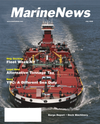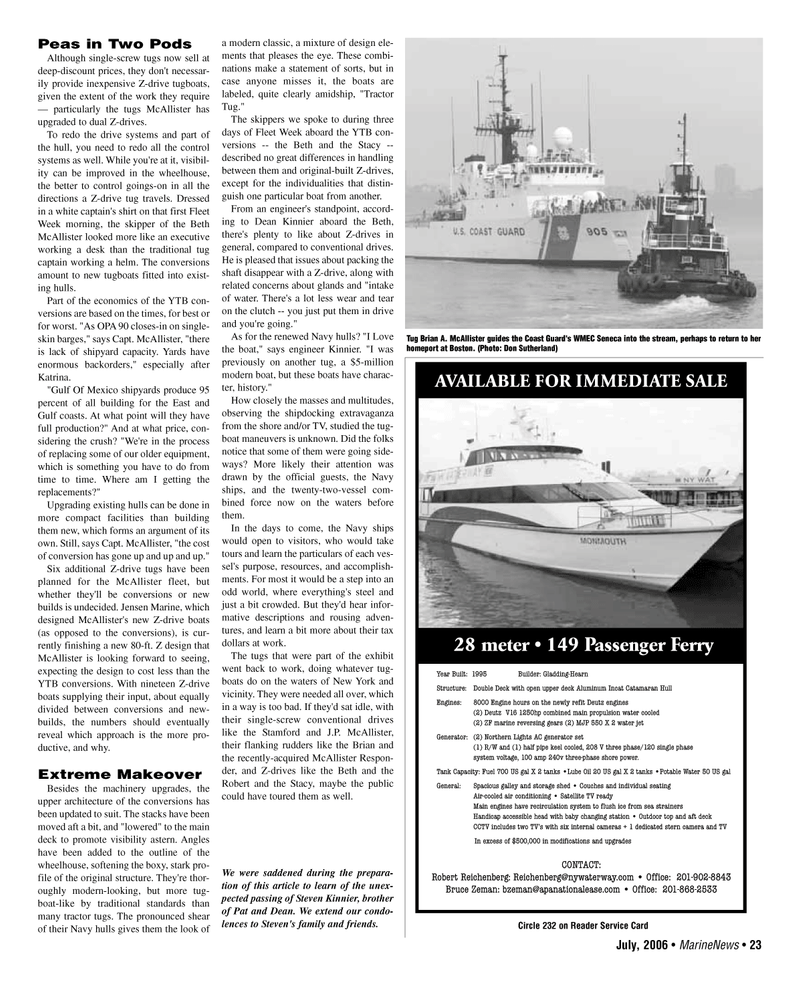
Page 23: of Maritime Reporter Magazine (July 2006)
The Satellite Communication Edition
Read this page in Pdf, Flash or Html5 edition of July 2006 Maritime Reporter Magazine
Peas in Two Pods
Although single-screw tugs now sell at deep-discount prices, they don't necessar- ily provide inexpensive Z-drive tugboats, given the extent of the work they require — particularly the tugs McAllister has upgraded to dual Z-drives.
To redo the drive systems and part of the hull, you need to redo all the control systems as well. While you're at it, visibil- ity can be improved in the wheelhouse, the better to control goings-on in all the directions a Z-drive tug travels. Dressed in a white captain's shirt on that first Fleet
Week morning, the skipper of the Beth
McAllister looked more like an executive working a desk than the traditional tug captain working a helm. The conversions amount to new tugboats fitted into exist- ing hulls.
Part of the economics of the YTB con- versions are based on the times, for best or for worst. "As OPA 90 closes-in on single- skin barges," says Capt. McAllister, "there is lack of shipyard capacity. Yards have enormous backorders," especially after
Katrina. "Gulf Of Mexico shipyards produce 95 percent of all building for the East and
Gulf coasts. At what point will they have full production?" And at what price, con- sidering the crush? "We're in the process of replacing some of our older equipment, which is something you have to do from time to time. Where am I getting the replacements?"
Upgrading existing hulls can be done in more compact facilities than building them new, which forms an argument of its own. Still, says Capt. McAllister, "the cost of conversion has gone up and up and up."
Six additional Z-drive tugs have been planned for the McAllister fleet, but whether they'll be conversions or new builds is undecided. Jensen Marine, which designed McAllister's new Z-drive boats (as opposed to the conversions), is cur- rently finishing a new 80-ft. Z design that
McAllister is looking forward to seeing, expecting the design to cost less than the
YTB conversions. With nineteen Z-drive boats supplying their input, about equally divided between conversions and new- builds, the numbers should eventually reveal which approach is the more pro- ductive, and why.
Extreme Makeover
Besides the machinery upgrades, the upper architecture of the conversions has been updated to suit. The stacks have been moved aft a bit, and "lowered" to the main deck to promote visibility astern. Angles have been added to the outline of the wheelhouse, softening the boxy, stark pro- file of the original structure. They're thor- oughly modern-looking, but more tug- boat-like by traditional standards than many tractor tugs. The pronounced shear of their Navy hulls gives them the look of a modern classic, a mixture of design ele- ments that pleases the eye. These combi- nations make a statement of sorts, but in case anyone misses it, the boats are labeled, quite clearly amidship, "Tractor
Tug."
The skippers we spoke to during three days of Fleet Week aboard the YTB con- versions -- the Beth and the Stacy -- described no great differences in handling between them and original-built Z-drives, except for the individualities that distin- guish one particular boat from another.
From an engineer's standpoint, accord- ing to Dean Kinnier aboard the Beth, there's plenty to like about Z-drives in general, compared to conventional drives.
He is pleased that issues about packing the shaft disappear with a Z-drive, along with related concerns about glands and "intake of water. There's a lot less wear and tear on the clutch -- you just put them in drive and you're going."
As for the renewed Navy hulls? "I Love the boat," says engineer Kinnier. "I was previously on another tug, a $5-million modern boat, but these boats have charac- ter, history."
How closely the masses and multitudes, observing the shipdocking extravaganza from the shore and/or TV, studied the tug- boat maneuvers is unknown. Did the folks notice that some of them were going side- ways? More likely their attention was drawn by the official guests, the Navy ships, and the twenty-two-vessel com- bined force now on the waters before them.
In the days to come, the Navy ships would open to visitors, who would take tours and learn the particulars of each ves- sel's purpose, resources, and accomplish- ments. For most it would be a step into an odd world, where everything's steel and just a bit crowded. But they'd hear infor- mative descriptions and rousing adven- tures, and learn a bit more about their tax dollars at work.
The tugs that were part of the exhibit went back to work, doing whatever tug- boats do on the waters of New York and vicinity. They were needed all over, which in a way is too bad. If they'd sat idle, with their single-screw conventional drives like the Stamford and J.P. McAllister, their flanking rudders like the Brian and the recently-acquired McAllister Respon- der, and Z-drives like the Beth and the
Robert and the Stacy, maybe the public could have toured them as well.
We were saddened during the prepara- tion of this article to learn of the unex- pected passing of Steven Kinnier, brother of Pat and Dean. We extend our condo- lences to Steven's family and friends.
July, 2006 • MarineNews 23
CONTACT:
Robert Reichenberg: [email protected] • Office: 201-902-8843
Bruce Zeman: [email protected] • Office: 201-868-2533
AVAILABLE FOR IMMEDIATE SALE 28 meter • 149 Passenger Ferry
Year Built: 1995 Builder: Gladding-Hearn
Structure: Double Deck with open upper deck Aluminum Incat Catamaran Hull
Engines: 8000 Engine hours on the newly refit Deutz engines (2) Deutz V16 1250hp combined main propulsion water cooled (2) ZF marine reversing gears (2) MJP 550 X 2 water jet
Generator: (2) Northern Lights AC generator set (1) R/W and (1) half pipe keel cooled, 208 V three phase/120 single phase system voltage, 100 amp 240v three-phase shore power.
Tank Capacity: Fuel 700 US gal X 2 tanks •Lube Oil 20 US gal X 2 tanks •Potable Water 50 US gal
General: Spacious galley and storage shed • Couches and individual seating
Air-cooled air conditioning • Satellite TV ready
Main engines have recirculation system to flush ice from sea strainers
Handicap accessible head with baby changing station • Outdoor top and aft deck
CCTV includes two TV’s with six internal cameras + 1 dedicated stern camera and TV
In excess of $500,000 in modifications and upgrades
Circle 232 on Reader Service Card
Tug Brian A. McAllister guides the Coast Guard's WMEC Seneca into the stream, perhaps to return to her homeport at Boston. (Photo: Don Sutherland)
JULY MN2006 3(17-24).qxd 7/6/2006 11:40 AM Page 23

 22
22

 24
24
